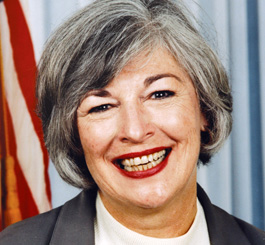home | north bay bohemian index | news | north bay | news article

GO OUT WITH A BANG: If you're gonna retire soon anyway, you might as well request federal funds for a handful of worthy North Bay projects.
Bending Your Ear
Rep. Lynn Woolsey earmarks the heck out of the 2011 budget
By Paul Wagner
Twenty-eleven. The Year of the Rabbit, in the Chinese lunar calendar (emphasis: diplomacy). The International Year of Forests and the Year of Chemistry, says the United Nations.
It's also the year that Lynn Woolsey, 10-term representative whom the Bohemian has consistently endorsed, may well announce her retirement. She's made no secret of the fact that at 73, having served 20 consecutive years in the House, she may be ready for some rest and relaxation by 2012.
Meanwhile, if incoming House and Senate GOPs stick to their word, this may be the Year of Last-Ever Earmarks. After all, earmarks are very unpopular—except, of course, when they fund our districts. The wasteful funds funneling into those other 434 districts? Unnecessary and unjustifiable. Criminal, in fact. Always has been; the term "eare-marke" (circa 1590) originally meant "a cut or mark in the ear of sheep and cattle, serving as a sign of ownership (also a punishment of certain criminals)."
Apparently, earmarks have always, among decent people, been associated with criminality. Especially within the brand-spanking-new congressional Tea Party Caucus, which has condemned them as brazenly unconstitutional and whose members then promptly requested $1 billion worth of them.
But since this may be the last chance the honorable Ms. Woolsey ever gets to marke any eares, let's take a look at what may be her last-ever special funding requests. Namely, the earmarks she's attached to the proposed 2011 federal budget. Of which there are 84.
Immediately remarkable about Woolsey's list is how many medical and health-oriented requests there are. For example, we find an $812,050 request for "Equipment to Further Geroscience, Study of the Connection Between Aging and Disease." It would purchase an iSeq 2000 device, whose maker lists it as "the first commercially available sequencer to enable researchers to obtain 30x coverage of two human genomes in a single run for under $10,000 per sample." Pretty slick.
There's also a $250,000 "Geriatric Specialty, Community Outreach and Education" program for Sonoma Valley Hospital. And a $1 million "Geroscience Demonstration Prevention Study" looking into "mechanisms by which common disease prevention measures—dietary restriction, exercise and stress reduction—affect aging and health outcomes."
But there's solid brick-and-mortar stuff, too. Woolsey has asked for $775,000 in funds for a public health outreach program in Marin City, $215,500 to build a new clinic in Santa Rosa, $8 million for an integrated hospital information system, $3 million for an electronic records system for the Palm Drive Hospital District and another $1 million for a web-based patient portal.
And, reflecting the troublingly high incidence of breast cancer in the region, the list includes digital mammography equipment for the St. Joseph Health System ($300,000), as well as for Marin County–specific breast cancer research ($500,000).
Woolsey has also asked for funding to aid several oft-ignored populations. There's nearly $1 million to solidify state action on the trafficking of women and girls. Helping women and families become more independent is the point of her proposed $400,000 program of "Economic Self Sufficiency for Low-Income Women Entrepreneurs." And a $110,000 "Enhanced Direct Services to Sexual Assault Survivors" earmark would expand the Santa Rosa program to aid adult survivors as well.
Perhaps the most creatively remarkable is a program titled "Breaking the Intergenerational Cycle of Incarceration." "Funding," says Project Avary, the Novato-based group that proposes it, "will be used to improve youth outcomes for children of incarcerated parents through earlier intervention, more rigorous prevention training for pre-adolescent children ages eight to 10, and training for independent living for teens." That's quite a bit of compassionate intervention for $143,275.
Woolsey's next largest set of earmarks is for transportation improvements. They include compressed natural gas buses for Sonoma County at $2 million, and hybrid models for the city of Santa Rosa for $2.58 million. Also included is $25 million for Golden Gate Bridge seismic retrofits; $5 million for Sausalito Ferry ramps and gangways; $1.1 million each for spiffing up Highway 101 and the Highway 116/121 roundabout; $3.4 million to add some spit and polish (including bicycle overcrossings) to the Marin-Sonoma narrows; $2.24 million in shuttles for the Muir Woods; $5 million for commuter rail construction; $3.6 million for the Pacific Way Bridge; and—wave of the future—a $374,000 electrical vehicle fleet and charging station for the Sonoma County Transportation Authority.
Ever committed to the environment, Woolsey also includes green enhancements as a large sector of earmarks, most involving water. These include requests to fund hydrometering, flooding studies, pipelines, canal dredging, watershed and river restoration, improved lake access, more detailed collection of coastal data and a gigantic $5 million water research project studying "the impacts of pharmaceutical/EDCs in water . . . drought response, desalination, wastewater reuse . . . and treating water contaminants."
Which of these will actually pass and be signed into law? Nobody knows. As of this writing, GOP senator Mitch McConnell has succeeded in rallying his troops to vote down the current 2011 federal budget proposal because roughly 1 percent of it is made up of, y'know, earmarks—including $85 million of his own—and that's just intolerable.
Stay tuned for interesting times. The Year of the Rabbit has not yet begun to hop.
Send a letter to the editor about this story.
|
|
|
|
|
|